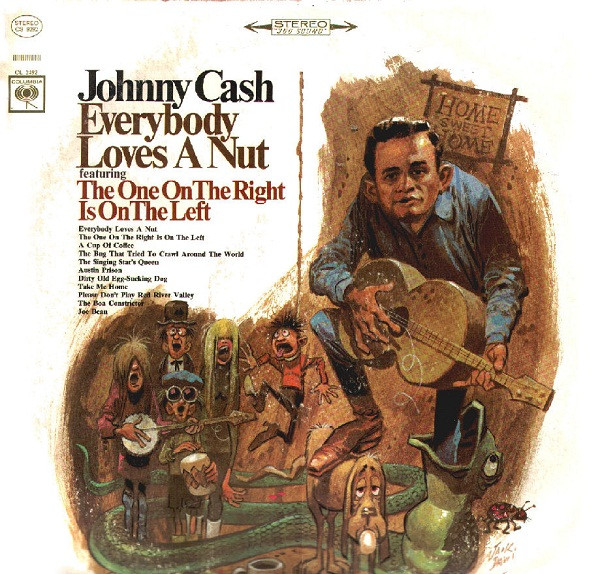
“The One on the Right Is on the Left” (1966) – Johnny Cash * Written by Jack Clement * Produced by Don Law and Frank Jones * 45: “The One on the Right Is on the Left” / “Cotton Pickin’ Hands” * LP: Everybody Loves a Nut * Label: Columbia * Billboard Charts: Country (#2); Hot 100 (#46)
Johnny Cash’s “The One on the Right Is on the Left” depicts a folk group whose incompatible politics bring them to an onstage brawl. Written by Jack Clement, the 1966 country hit appeared on an album called Everybody Loves a Nut with artwork by Mad magazine’s Jack Davis, and it rose up in the wake of two massive pop hits with folk panache and opposing viewpoints: Barry McGuire’s “Eve of Destruction” (#1, 1965) and S Sgt Barry Saddler’s “Ballad of the Green Berets” (#1, 1966). “Keep your politics to yourself” is the moral, which is usually the type of thing people with strong political views say about outspoken people with contradictory ones. Country audiences, after all, later adored brazen political songs by Merle Haggard, Guy Drake, and others.
But Cash was a rare bird who managed to straddle the middle ground in a polarized era. He showed deference for elected leaders in word and deed (for the most part—at a 1972 White House concert, he brushed off Nixon’s request to play Drake’s “Welfare Cadilac” (sic)). He also maintained a hardcore country audience even while voicing stances sympathetic to the American left (“What Is Truth?,” “Singin’ in Vietnam Talkin’ Blues,” the Bitter Tears album).
What’s interesting about “The One on the Right Is on the Left” is that the consequences he depicts for this band with messy politics go inward. It’s the band who pays the price. Cash’s own willingness to take on political topics in later years indicates that his heart was in this interpretation, that a band divided cannot stand. If a band is in agreement, on the other hand, let the topicality commence. This makes sense and applies especially to the hyper-polarized current era, where the middle ground is ever-elusive, where band members are liable to go rogue and maintain alternate political personas through social media, and struggle, on the road or between sets, to have stress-free conversations.
When did the flatted seventh resolving to natural (heard later in the song during the “land” parts of “folk songs of our land”) become a “great frontier” signifier and why? I think about it as being a transition that goes deeper than we expect, so it gives us a feeling of poignancy. It sounds like a near-loss of footing that finds recovery, symbolizing the countless recoveries that eventually tamed the frontier. Follow me? It shows up in Western themes all throughout the ’60s and ’70s and can likely just be chalked up as an Elmer Bernstein innovation. He used it in his theme for The Big Country (1958), and again in The Magnificent Seven (1960). That’s probably all it took to catch on.
